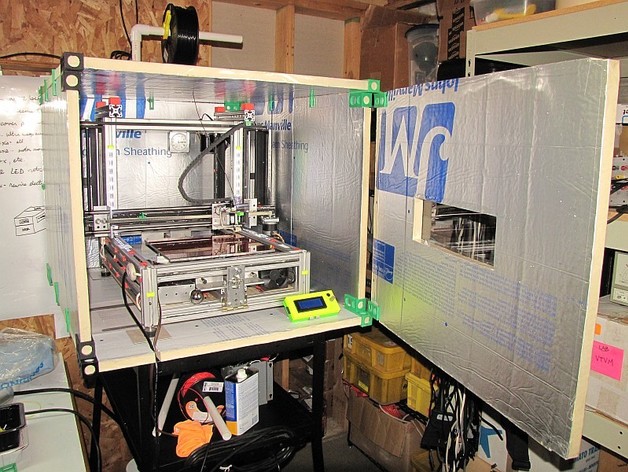
Thermal Enclosure For 3D Printer
thingiverse
Update: It appears that I hadn't originally uploaded the STL file for the rear corners; however, it's now available. Large ABS 3D prints may delaminate during printing if not kept warm. This project offers a solution by providing printable parts to create a thermally insulating box from 1" PIR foam to protect your printer. The design includes printed pieces for holding the foam boards, which are particularly useful when transporting your printer. If you don't need to move your printer, duct tape can be used instead of printing the holding pieces. To use this system, measure your printer and calculate the sizes of the foam pieces required. Cut the foam according to the specified configuration or the printed parts may not fit correctly. A 1" PIR foam with foil on both sides was used due to its fire-retardant properties, but polystyrene foam might also suffice. You will need four rear corners, two front corners, and two hinge assemblies. Print as many clips as needed for your box size. The corner pieces and hinges are printed in two parts to avoid the use of support material during printing; they are then superglued together. Use a 3-5mm brim when printing to prevent corners from lifting off the print bed. Tape the edges of the foam pieces with packing tape or duct tape to prevent damage, and consider placing pieces of masonite or wood under your printer's feet for added support. The hinges are designed for 6-32 screws, which fit tightly into the door hinge pieces but loosely in the box hinge piece. It is recommended to move the printer's electronics outside of the box, as heat and electronics don't mix well. To assemble the box, follow these steps: 1) cut notches in the foam and attach clips, corners, and hinges to the bottom piece; 2) place your printer on the foam base; 3) add suitably notched back and side pieces of foam; 4) attach the clips, corners, and hinge to the top piece; 5) place the top on the box; 6) attach the door to the hinge; 7) cut notches/holes for filament, cables, and windows as needed. Although sealing the box air-tight isn't necessary, you can use packing tape as 'weather strips' at the edges of the foam boards if desired. In some cases, leaving the door slightly open might be required to prevent the internal temperature from rising above 42°C. A large print taking around 15 hours was tested inside the box with no delamination issues.
With this file you will be able to print Thermal Enclosure For 3D Printer with your 3D printer. Click on the button and save the file on your computer to work, edit or customize your design. You can also find more 3D designs for printers on Thermal Enclosure For 3D Printer.
